Up Next

An in-depth breakdown of a magical George Russell Spa-Francorchamps lap that would go on to be overshadowed by Sunday’s non-race is Valentin Khorounzhiy’s pick as one of the highlights of our coverage this year.
It’s a qualifying lap that will go down in the history books: George Russell second on the grid in a Williams around a wet Spa, out-qualifying both Mercedes and falling short only of Max Verstappen’s downforce-heavy Red Bull.
There are the hard technical points of this achievement – how he built it up over two consecutive push laps on a used set of intermediates, the implications of that upon the energy recovery, how the downforce levels of the Williams compared to that of the Red Bull – but then there are the physical, human inputs which encompassed all that and delivered the spectacular outcome.
In the dry the Williams remains a marginal Q1/Q2 level of car, one which is dependent upon the quality of the driver’s lap to make it through, a task that Russell is inevitably up to. If others in the midfield pack then have dramas, Russell might even sneak it into Q3. But in the wet there’s always opportunity for an ambush, for a smartly-run team and a brilliant driver to put it all together. Especially around Spa.
“The big thing was how much confidence the car gave me,” said Russell afterwards. “Right from FP3 this morning it felt really nice and that just gave me that confidence which in these conditions is worth so much. I really had that today.”
That the car was nicely balanced was underlined by the form of Nicholas Latifi, over one second off Russell’s pace but comfortably through Q1 in 10th, ahead of Carlos Sainz’s Ferrari, Daniel Ricciardo’s McLaren and the struggling Alpines.
With such a balance and the rain making the circuit different every lap, a driver of Russell’s sensitivity could really make a spectacular difference. All it needed was the right calls on the pitlane on a day when it was oh-so-easy to make the wrong ones – on the timing of the runs especially.
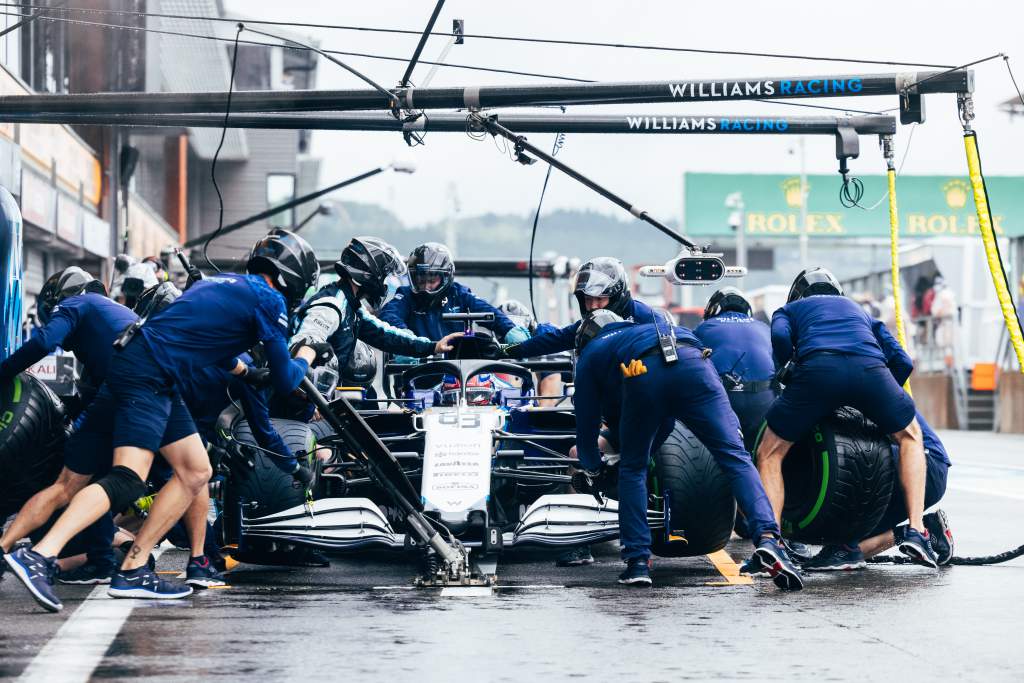
But with the team doing a brilliant job in that department, Russell’s improvisation and feel, the way he combines big balls commitment with silky smooth car whispering, was left to do the rest. This is how it all unfolded in that last run of Q3, as the session was restarted following the Lando Norris-induced red flag.
Williams sent him out on wets, but it was soon obvious the track was dry enough for the intermediates which everyone else (apart from Esteban Ocon) had chosen. Coming straight back in put him out-of-synch with the others, most of whom were planning to do a push-cool-push lap sequence.
Russell had time only for two laps after stopping for his inters. These were a used set, as there were no new ones left, but there was felt to be no great disadvantage to that. In fact they are often actually quicker than a new set on the first lap.
The problem was the energy deployment of two consecutive long laps of Spa. Given that the track was becoming drier, the plan, revealed to Russell as he was between Turns 9 and 10 on the out-lap was a semi-push first lap using full deployment only at the beginning of the lap, then switching settings so that full deployment would be available for the second lap on the drier track.
So that first semi-push lap was used primarily to bring the tyres and brakes to their optimum temperature, guided by his engineer throughout the lap. Eau Rouge was extra tricky this year, with the bump created by repairs after the recent mud slides. It comes at an awkward place, just as the car is rising out of the full compression at the bottom of the hill and is being loaded to the left.
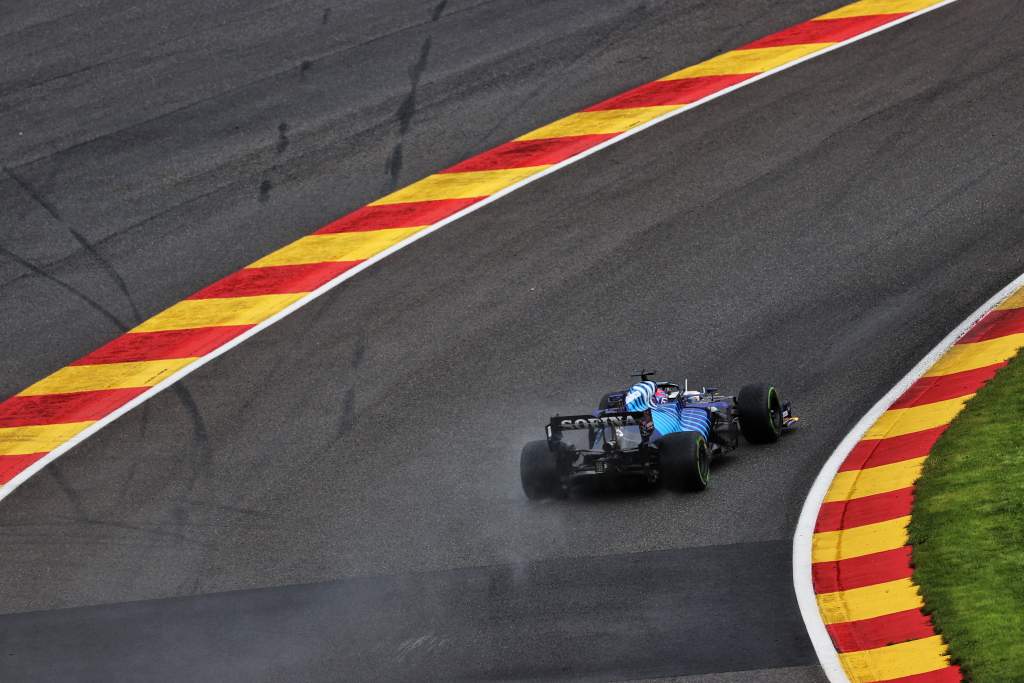
On the wet track it required a lift and a downshift – from eighth to seventh – from everyone. Even Verstappen in the Red Bull with the bigger of its two available rear wings and its naturally ample underbody downforce.
It was a given the Red Bull would be the fastest thing in the place through the long fast sweeps of the middle sector. But there might be time to be taken out of it down the long Kemmel straight – only if you could come out of Eau Rouge at a competitive speed. Russell practiced it on that semi-push lap and it felt good. “That’s where you really needed confidence in the car,” he related. “The track is different every lap and in Q3 it was maybe 4s slower than at the end of Q2 so you don’t really know how quick you can go into Eau Rouge.”
So this lap was as much about George’s preparation as car-prep. And although the ‘HPP’ (full deployment setting) was turned off before Pouhon, already there were clues about how the real lap was going to look, with Russell’s beautiful one-arc steering inputs and the way he was turning into the slower corners very early, loading up the front tyres progressively and using the brakes to transfer the weight, staying away from the rubber build-up by going inside it when the more conventional wet karting line was to go around it on the outside, like Verstappen: “Yeah, I was trying to not cross over the rubber because you could feel the car get upset as it went over.”
Flat through Blanchimont was another nice detail, ridding him of any ambiguity next time.
Corner-by-corner: How Russell did it
A very calm exit from the Bus Stop, getting the car straight early to maximise its traction and its speed across the start/finish line, with braking for La Source following almost immediately. Here was where Russell’s early turn-in was at its most distinctive, as he just dived for that inside kerb from a long way back.
Verstappen here would make no attempt to get anywhere near that kerb, but just ran wall-of-death style around the outside keeping up more momentum but travelling a much greater distance. Which was quicker only a telemetry comparison would reveal, but visually it looked like Russell’s, though it entailed some wheelspin out of the corner, beautifully damped by Russell’s right foot.
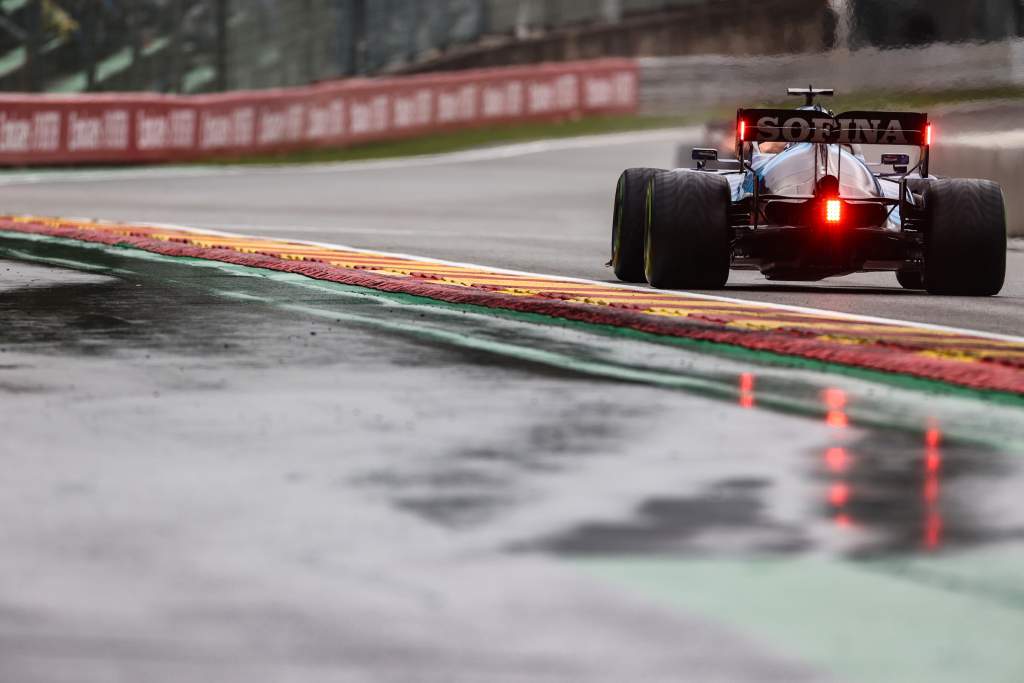
Charging down the hill up to eighth gear, spray teeming off the left front so it looks just like a permanent cloud above the tyre, he takes a daring amount of the yellow kerb on the left as he enters Eau Rouge, giving him a lot of momentum up the hill to the part where Norris had first began losing control earlier.
This is where that awkward bump is and there’s a brief lift and a pitch change as he downshifts to seventh, but then gets back full on it audaciously early. Much earlier than on his last, quite adventurous, approach and earlier than Verstappen would subsequently dare.
It’s the most dangerous part of the track, the conditions were awful but George was incredibly committed – and the reward for that carried all the way down the Kemmel Straight to end sector one a full half-second faster than anyone. This was the foundation of the lap. All he had to do now was try not to lose too much time – to the Red Bull in particular – through the downforce-demanding middle sector.
Here’s where Russell’s car-whispering skills were seen to wonderful effect. He’s very patient with the throttle through Les Combes sequence, just keeping momentum. The slightest flare of wheelspin is quickly damped before it takes a hold.
There’s a bit of oversteer exit of Turn 7 (Malmedy) then full chat down to the tricky Rivage and its downhill approach. Big entry speed and a bit of rear instability but total calmness in how it’s controlled, no sudden movements and just letting the car roll into the first part of the corner, off throttle.
THAT moment 💙 pic.twitter.com/RPUmEnEW9U
— Williams Racing (@WilliamsRacing) August 28, 2021
There’s a beautiful sense of momentum about it, like he has lots of frames per second in how he’s judging the trade-off, no panic in the movements even though the car’s occasional snarls of broken traction or niggle of instability remind you that it’s actually on the edge of control. That’s the only betrayal.
It’s as if he’s whispering the car around, conning it into not believing it’s going as fast as it is – and every time it momentarily realises and snaps at him, he’s there instantly soothing it, ‘Look, I’m hardly doing anything, all nice and smooth, we’re not going that fast see, just stay calm.’ It’s a very different feel to the typically more spectacular laps you’ll see from Leclerc, Norris or Verstappen.
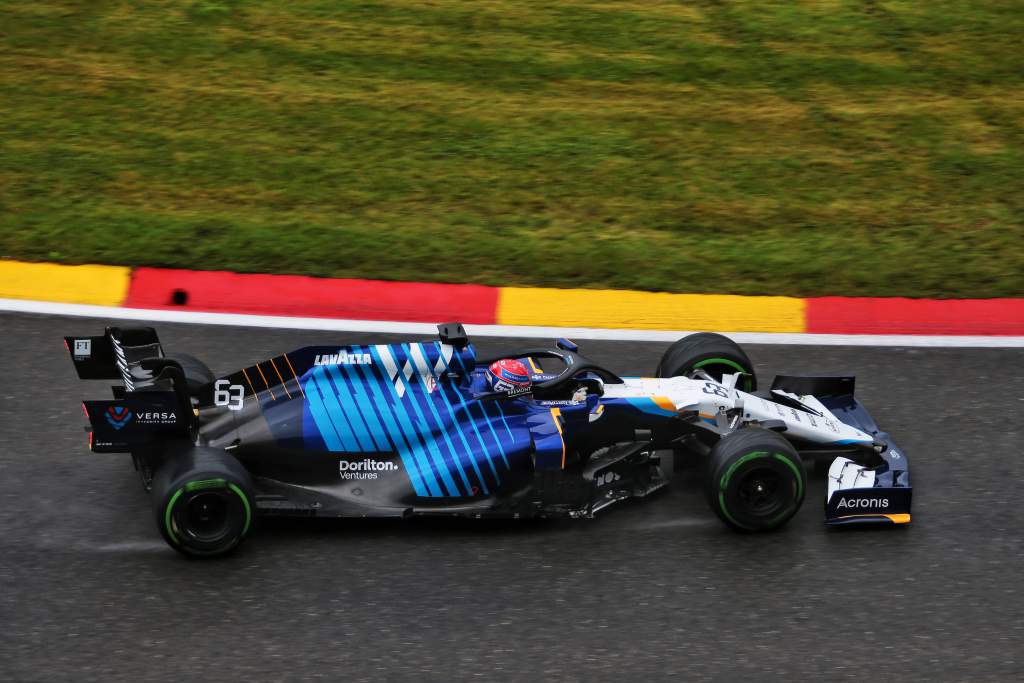
The track’s noticeably drier on this lap into Liege (aka ‘corner with no name’) and he’s visibly more adventurous with entry speed than last time. Two downchanges for Pouhon to sixth for better control of the car’s attitude, plenty of exit kerb despite the wet – he’s felt what the grip was like there last time. A little flick of protest as the rear wheels straddle that different surface as he rejoins, but it’s over and back on the tarmac before it builds into anything.
Then quite an aggressive initial braking into the Fagnes chicane, really feeling the surface grip under his left foot, enough to jerk his head forward. The violence of braking power is at odds with the smoothness of steering and throttle in the flowing parts of the lap. There is lap time in that braking power so it has to be taken. But just underlining the compartmentalisation of the tasks of the different limbs, doing totally different things in different ways. It’s like watching a jazz drummer.
Patience and throttle control through the left of Turn 13, the car with way more power than traction here and just held on the outer edges of that ledge for a couple of seconds, the hint of wheelspin calmed just before he reaches the painted white line on the exit. Perfect. Beautiful. Then over to the left for the right-hander of Stavelot, again a bit of car whispering correction on entry as he manipulates the weight with the brakes, making it a slow, unscary process.
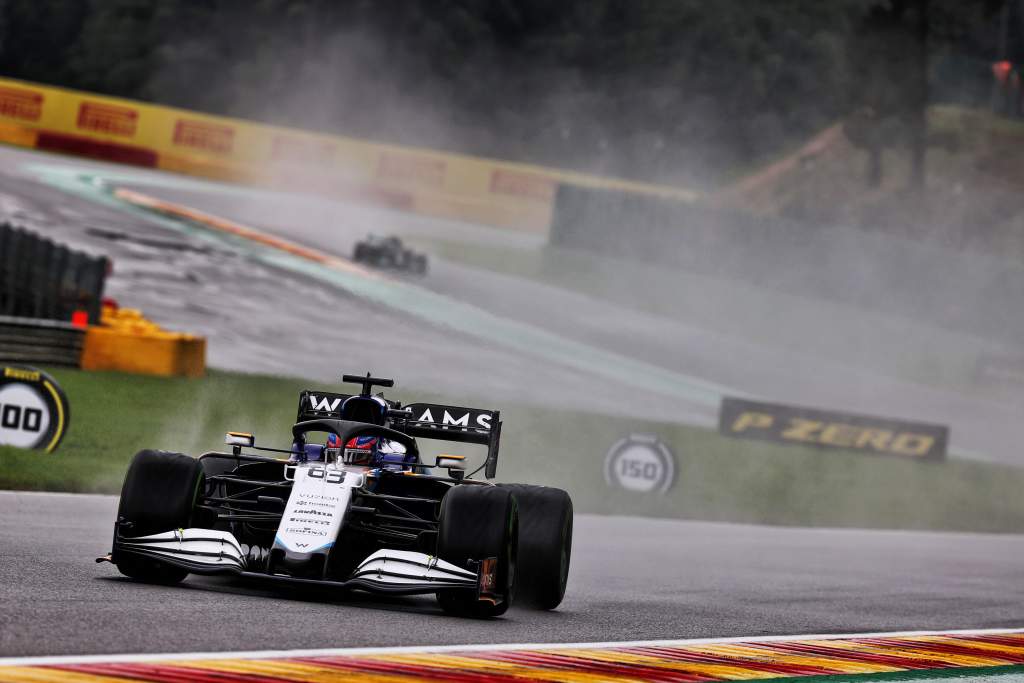
He lets the car steady itself on exit on the painted kerb before coming off and into Paul Frere for maximum smoothness and momentum onto the long flat-out section that’s coming up. He’s dropped only 0.269s in that sector to a Red Bull that would typically be half-a-second or more faster than a Williams through there in the dry. It’s the third-fastest anyone goes through there in Q3.
Flat in top through Blanchimont, spray shrouding the inner front tyre all the way through and only clearing, like a gap in the clouds, as the speed comes down during braking for the Bus Stop. A brief lock of the outer-front but he’s so overlapping the braking and turning that he can just release some pedal pressure and use more steering. The car barely notices.
No, this isn’t a dream. This is what happens when you keep believing. @WilliamsRacing on the front row. Back where we belong. 👊 pic.twitter.com/4iO6LYRgki
— George Russell (@GeorgeRussell63) August 28, 2021
He’s still early and calm into there and the little excess speed is bled away with some mid corner understeer to shave it off, George deliberately exaggerating the steering to control this very dynamic balance. But still plenty of time to get a good line through the left-hand part of it onto the pit straight.
Glory awaits just a few tenths of a second down the line.





